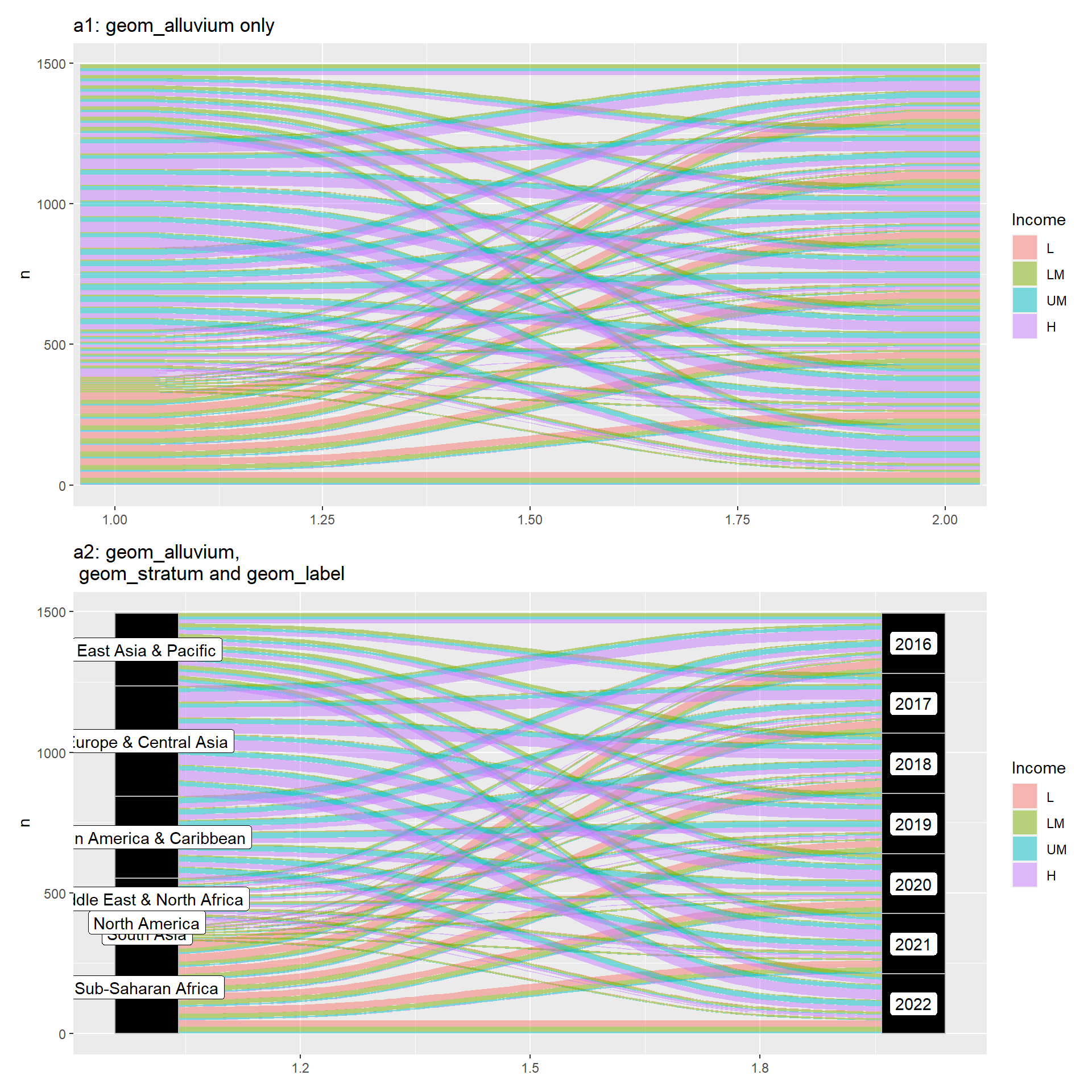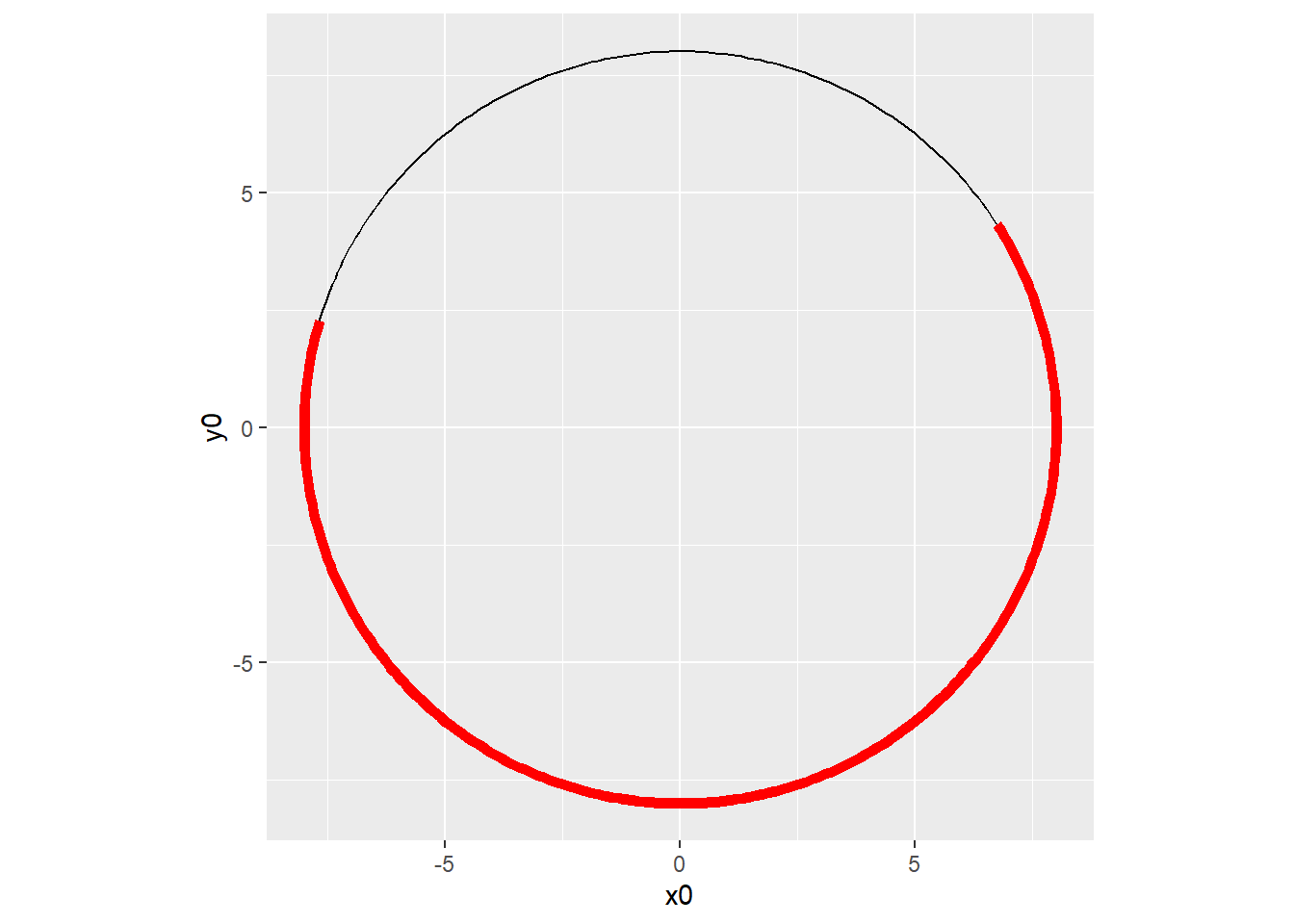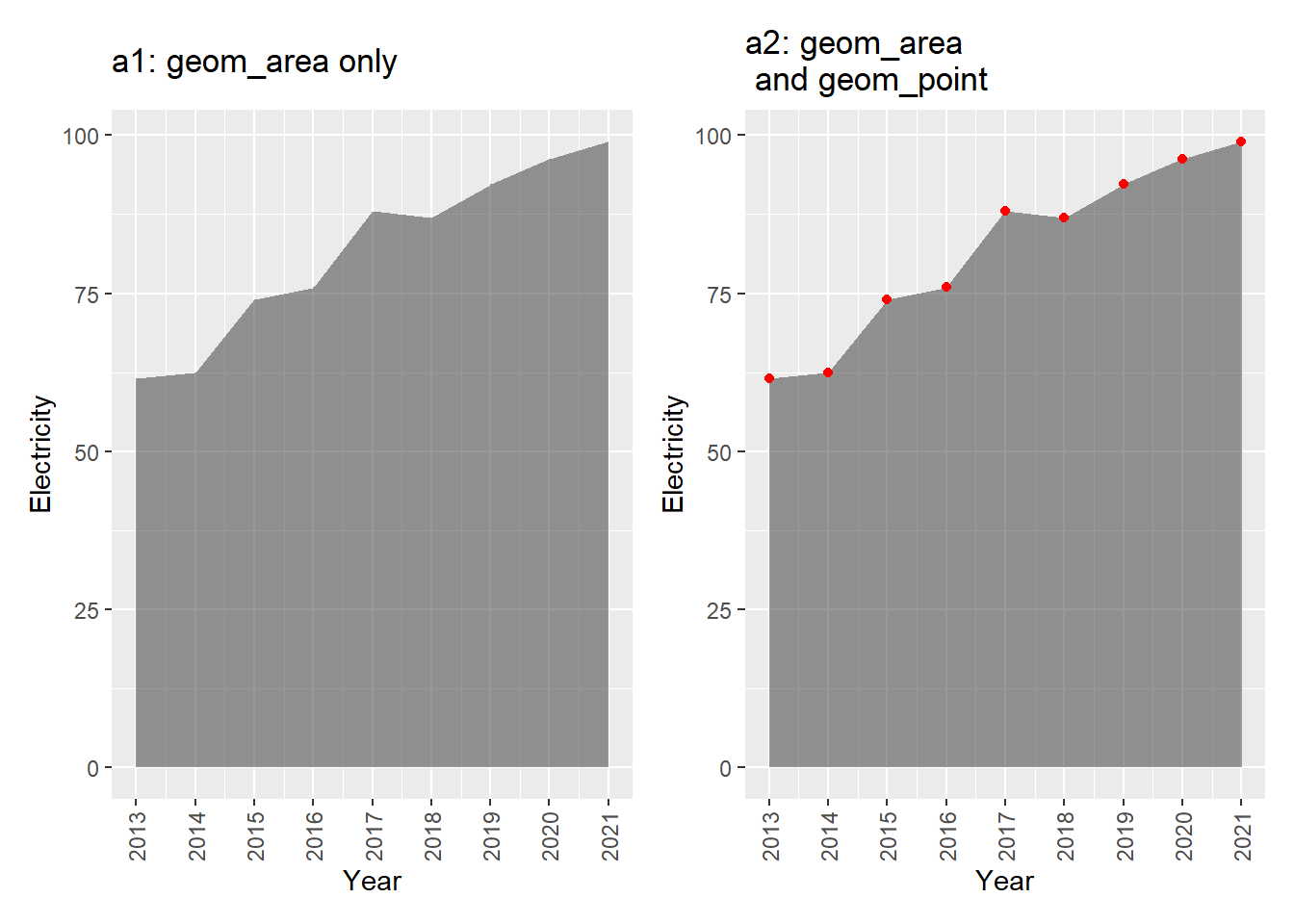geom_abline
Package
ggplot2 (Wickham 2016 )
Description
Description Draw a straight line (\(Y=mX+c\) ) for a given slope (\(m\) ) and intercept (\(c\) ).
Understandable aesthetics
Unlike most other geoms, geom_abline does not depend on the x and y variables that we map for the main plot. geom_abline has its own independent characteristics: intercept and slope.
See also
geom_point , geom_vline , geom_hline
Example
<- ggplot (worldbankdata, aes (y = Cooking, x = Electricity)) + geom_abline (intercept = 0 , slope = 1 ) + labs (title = "a1: geom_abline only" ) + theme (aspect.ratio = 1 )<- ggplot (worldbankdata, aes (y = Cooking, x = Electricity)) + geom_abline (intercept = 0 , slope = 1 ) + geom_point () + labs (title = "a2: geom_abline \n and geom_point" ) + theme (aspect.ratio = 1 )| a2
geom_alluvium
Package
ggalluvial(Brunson and Read 2019 ; Brunson 2020 )
Description
Create alluvial plot. An alluvial plot is a type of diagram that is particularly useful for visualizing categorical data and the flow or transition between different categorical variables over multiple stages or categories
Understandable aesthetics
required aesthetics
x, y, ymin, ymax,
optional aesthetics
alpha, colour, fill, linetype, size, group (group is used internally; arguments are ignored)
See also
geom_stratum , geom_flow , geom_lode
Example
library (ggalluvial)<- worldbankdata |> select (Country, Region, Year, Income) |> filter (Year > 2019 ) |> filter (Region %in% c ("East Asia & Pacific" , "North America" )) |> group_by (Region, Year, Income) |> summarise (n = n ()) |> drop_na ()
# A tibble: 12 × 4
# Groups: Region, Year [6]
Region Year Income n
<fct> <dbl> <fct> <int>
1 East Asia & Pacific 2020 LM 14
2 East Asia & Pacific 2020 UM 8
3 East Asia & Pacific 2020 H 15
4 East Asia & Pacific 2021 LM 14
5 East Asia & Pacific 2021 UM 9
6 East Asia & Pacific 2021 H 14
7 East Asia & Pacific 2022 LM 13
8 East Asia & Pacific 2022 UM 9
9 East Asia & Pacific 2022 H 15
10 North America 2020 H 3
11 North America 2021 H 3
12 North America 2022 H 3
<- freq.table |> ggplot (aes (y = n, axis1 = Region, axis2 = Year)) + geom_alluvium (aes (fill = Income), width = 1 / 12 ) + scale_fill_brewer (palette = "Dark2" ) + labs (title = "a1: geom_alluvium only" )<- freq.table |> ggplot (aes (y = n, axis1 = Region, axis2 = Year)) + geom_alluvium (aes (fill = Income), width = 1 / 12 ) + geom_stratum (width = 1 / 12 , fill = "black" , color = "grey" ) + geom_label (stat = "stratum" , aes (label = after_stat (stratum))) + scale_fill_brewer (palette = "Dark2" ) + labs (title = "a2: geom_alluvium, \n geom_stratum and geom_label" )/ a2
geom_arc
Package
ggforce(Pedersen 2022 )
Description
Draw a circle or a segment of a circle.
Understandable aesthetic
required aesthetics
x0 - starting coordinate of x-axis , y0 - starting coordinate of x-axis, r - radius, start, end
optional aesthetics
color, linewidth, linetype, alpha, lineend
The statistical transformation to use on the data for this layer
stat_arc
See also
geom_arc2 , geom_arc_bar
Example
library (ggforce)ggplot () + geom_arc (aes (x0 = 0 , y0 = 0 , r = 8 , start = 1 , end = 8 )) + geom_arc (aes (x0 = 0 , y0 = 0 , r = 8 , start = 1 , end = 5 ), col = "red" , size = 2 ) + theme (aspect.ratio = 1 )
geom_arc_bar
Package
ggforce(Pedersen 2022 )
Description
To draw pie chart and donut chart defining centre point, a radius and a start and end angle.
Understandable aesthetic
required aesthetics
x0 - starting coordinate of x-axis , y0 - starting coordinate of x-axis, r - radius, start, end
optional aesthetics
color, linewidth, linetype, alpha, lineend
The statistical transformation to use on the data for this layer
stat_arc
See also
geom_arc , geom_arc_bar
Example
<- data.frame (state = c ("A" , "B" , "C" ,"D" , "E" focus = c (0.2 , 0 , 0 , 0 , 0 ),start = c (0 , 1 , 2 , 3 , 4 ),end = c (1 , 2 , 3 , 4 , 2 * pi),amount = c (4 , 3 , 1 , 2 , 5 ),stringsAsFactors = FALSE ggplot (df) + geom_arc_bar (aes (x0 = 0 , y0 = 0 , r0 = 0 , r = 1 , amount = amount,fill = state, explode = focusstat = "pie" ) + scale_fill_brewer (palette = "Dark2" ) + theme (aspect.ratio = 1 )
geom_area
Package
ggplot2 (Wickham 2016 )
Description
Create an area plot. This cover the space between x-axis and line that connects the data points.
Understandable aesthetics
required aesthetics
x, y
optional aesthetics
alpha, colour, fill, group, linetype, linewidth
See also
geom_line , geom_ribbon
Example
<- worldbankdata |> filter (Country == "Bangladesh" ) |> filter (Year >= 2013 & Year <= 2021 ) |> ggplot (aes (x = Year, y = Electricity)) + geom_area (alpha = 0.5 ) + theme (axis.text.x = element_text (angle = 90 , vjust = 0.5 , hjust = 1 )) + scale_x_continuous (breaks = 2013 : 2021 ) + labs (title = "a1: geom_area only" )<- worldbankdata |> filter (Country == "Bangladesh" ) |> filter (Year >= 2013 & Year <= 2021 ) |> ggplot (aes (x = Year, y = Electricity)) + geom_area (alpha = 0.5 ) + theme (axis.text.x = element_text (angle = 90 , vjust = 0.5 , hjust = 1 )) + scale_x_continuous (breaks = 2013 : 2021 ) + geom_point (col = "red" ) + labs (title = "a2: geom_area \n and geom_point" )| a2
geom_arima
Package
ggdemetra
Example
Loading required package: RJDemetra
Attaching package: 'RJDemetra'
The following objects are masked from 'package:dplyr':
compute, count
Attaching package: 'ggdemetra'
The following object is masked from 'package:RJDemetra':
ipi_c_eu
The following object is masked from 'package:base':
raw
|> filter (Country == "Bangladesh" ) |> filter (Year >= 2013 & Year <= 2021 ) |> ggplot (aes (x = Year, y = Electricity)) + geom_line () + #geom_sa(color = "#155692", message = FALSE) + geom_arima (geom = "label" ,x_arima = - Inf , y_arima = - Inf , vjust = - 1 , hjust = - 0.1 ,message = FALSE )
Warning: Computation failed in `stat_arima()`.
Caused by error in `dataframe2ts()`:
! Error with the frequency: it must be equal to 12, 6, 4 or 2
geom_arrow
Package
metR (Campitelli 2021 )
Description
Draws directional arrows (like vectors) on a plot, which can represent directions or flows — such as wind directions, movement, or gradients. The arrow from (x, y) and pointing in the direction (dx, dy) (vector components).
Understandable aesthetics
required aesthetics
x
y
optional aesthetics
arrow,type, arrow.angle, arrow.length, arrow.ends, arrow.type
See also
geom_line , geom_ribbon
Example
library (metR)<- tibble:: tibble (x = c (10 , 20 , 30 , 40 , 50 ), # Longitude or X-coordinates y = c (1 , 2 , 3 , 4 , 5 ), # Latitude or Y-coordinates dx = c (1 , 0 , - 1 , 0 , 1 ), # Wind direction components (change in X) dy = c (1 , - 1 , 0 , 1 , 0 ) # Wind direction components (change in Y) ggplot (data, aes (x = x, y = y)) + geom_point (color = "#1b9e77" , size = 3 ) + geom_arrow (aes (dx = dx, dy = dy), color = "#d95f02" , size = 1 , arrow.type = "closed" ) + labs (title = "Wind Directions at Different Locations" , x = "Longitude" , y = "Latitude" )
geom_ash
Package
ggformula (Kaplan and Pruim 2023 )
Description
Plot Average Shifted Histogram (ASH). The ASH is a nonparametric probability density estimator derived from a collection of histograms.
Understandable aesthetics
required aesthetics
x
y
optional aesthetics
color, fill, bins, alpha, size
See also
geom_histogram , geom_density
Example
library (ggformula)<- worldbankdata |> filter (Income == "LM" ) |> ggplot (aes (x = Electricity)) + geom_ash (bins = 20 , color = "#d95f02" ) + labs (title= "Average Shifted Histogram" )<- worldbankdata |> filter (Income == "LM" ) |> ggplot (aes (x = Electricity)) + geom_histogram (aes (y = stat (density)), color = "black" , fill = "gray" ) + geom_ash (bins = 20 , color = "#d95f02" ) + labs (title = "Histogram and Average Shifted Histogram" )| p2
geom_axis_hive
Brunson, Jason Cory. 2020. “Ggalluvial: Layered Grammar for Alluvial Plots.” Journal of Open Source Software 5 (49).
Brunson, Jason Cory, and Quentin D Read. 2019. “Package ‘Ggalluvial’ .”
Campitelli, Elio. 2021.
metR: Tools for Easier Analysis of Meteorological Fields .
https://doi.org/10.5281/zenodo.2593516 .
Pedersen, Thomas Lin. 2022.
Ggforce: Accelerating ’Ggplot2’ .
https://CRAN.R-project.org/package=ggforce .
Wickham, Hadley. 2016.
Ggplot2: Elegant Graphics for Data Analysis . Springer-Verlag New York.
https://ggplot2.tidyverse.org .







